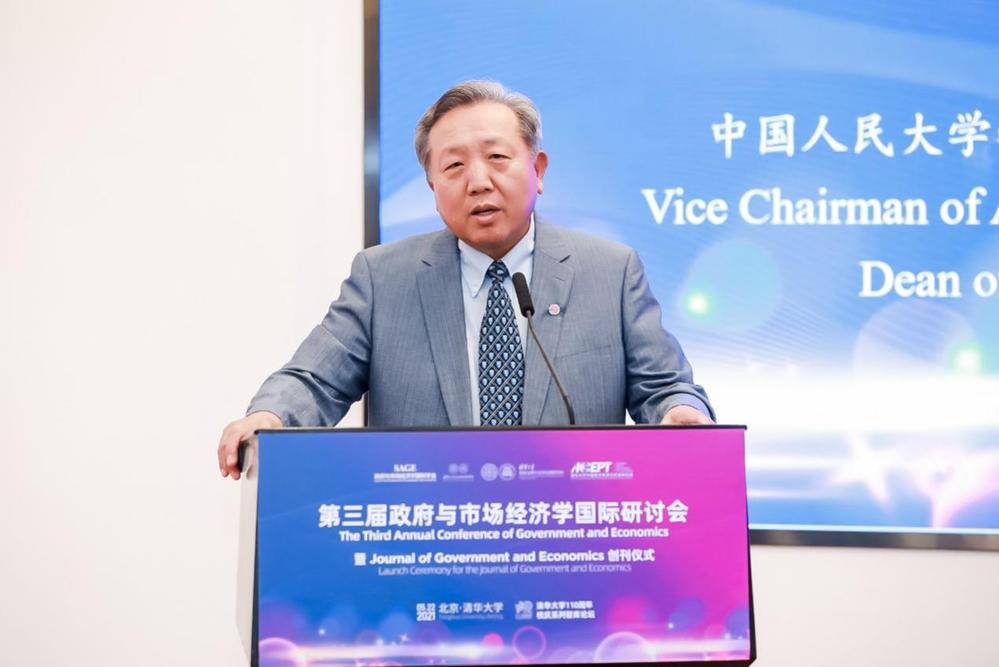Wu Xiaoqiu: Lessons in Government and Economics from China's 40 Years of Reform and Opening Up
The following is a translation of Wu Xiaoqiu's speech on May 22, 2021 at the Third Annual Conference of Government and Economics. Wu Xiaoqiu is the Vice Chairman of the Academic Committee of Renmin University of China and Dean of the China Capital Market Research Institute.

This annual conference is of great significance and features a pertinent topic. Indeed, since China initiated its reform and opening up more than 40 years ago, the country has successfully transitioned from an impoverished economy to a well-off society. In 1978, our per capita GDP amounted to only about 100 USD, but in 2020, the figure was close to 11,000 USD. This is a great miracle of human society.
It was indeed quite hard for people four decades ago to imagine that their country, so deeply entrenched in the system of a planned economy and natural economic thought, could be transformed into a modernized country after only forty years of growth. There must be some reasons behind such a wonder.
We usually speak of China’s path of economic growth in highly general terms, but exactly what factors were at play? In 1978, China even lagged behind India, while now we have surely achieved a higher level of GDP in total and per capita. Perhaps our Indian friends might disagree, arguing that Shanghai is still 20 years behind Mumbai. Nevertheless, in my opinion, China’s growth is indeed an amazing achievement, and its lessons require a thorough summary.
At the beginning of the reform period, we completely forsook the model of a planned economy that we had followed for the past 29 years. This path—the set of concepts, methods, policies, and rules of institutional design for the planned economy—was totally incompatible with the national conditions of China, and even for human society overall. The previous economic system severely constrained the enthusiasm and creativity of people and restrained the momentum of market entities to create wealth. Wealth is created by the market and requires competition, incentives, and division of labor in order to be generated. Without incentives and competition, there will be no wealth.
So does this mean that before 1978, Chinese people didn’t work hard? No, this isn’t the case—they worked hard and were very diligent. At that time, I was sent to the countryside with my parents, planting rice seedlings at night under the moonlight. Despite such hard work, our family still couldn’t accumulate wealth. That is because we took the wrong path—the harder we worked, the more impoverished we became. Therefore, the Third Plenary Session of the Eleventh Central Committee of the Communist Party of China made a historic choice for the future of our country—to launch the reform and opening up and follow the path of the market economy. From this experience, we have certainly learned many valuable lessons.
We abandoned the original system, rules, policies, and methods of the planned economy, which greatly stimulated the creativity of market entities and empowered everyone to have their own dreams. Still, there was the issue of emancipating people’s minds. In this respect, I think the most critical contribution of the Third Plenary Session of the Eleventh Central Committee of CPC was to emancipate people’s minds so that they could seek truth from facts, which has become the fundamental route and guiding principle of the reforms. A liberal mindset was indeed vital to China at that time. Looking through our history, the thinking of the Chinese nation was severely constrained due to its heavy spiritual shackles. Our nation was stuck in a backward state for a long time because its thinking suffered from severe constraints.
The Plenary Session liberated Chinese people’s minds and enabled them to seek truth from facts. Deng Xiaoping’s concluding remarks in the meeting sounded the clarion call for China’s modernization and for people to look forward in unison, cultivating a liberal and pragmatic mindset. Reading Deng’s speech today, my eyes still fill with tears. What a courageous man to deliver such a speech in that era with the planned economy so entrenched at that time! His remarks greatly inspired the immense creativity of the Chinese nation.
We have embarked on the path of the market economy, understanding over the past four decades that we needed to absorb the essence and grasp the soul of what it means to be a modern market economy. Regardless of the prefix that defines such an economy, the essence will always be there. For instance, prices shall be determined by the market as well as the relationship between supply and demand, the principle of market neutrality shall be followed, and market entities shall enjoy equal status in the allocation of resources. In addition, the principle of transparency shall be followed, and mechanisms of competition and incentive shall be established, etc. Moreover, measures need to be taken to protect all sorts of property rights, including intellectual property rights, and all forms of wealth. Only when people’s wealth and property are protected will they be motivated to create more wealth, allowing society to achieve progress accordingly. Regardless of the prefix that defines its nature, the soul of the market economy remains unchanged.
Over the past four decades, we have continued to explore and implement the essence of the market economy. In the meantime, we have integrated the market economy with China’s national circumstances, opting against the market economy model represented by the United States. If China had tried to achieve the transition from a planned economy system to such a highly liberalized market economy system, with the government only collecting taxes and engaging in small transfer payments to strike a balance between the rich and the poor, I’m afraid that wouldn’t have worked. Thus, we did not opt for the model of the former Soviet Union, neither did we completely replicate the market economy model as represented by the United States. Instead, we chose a third path, integrating the reasonable, scientific, and advanced elements of the market economy. As the foundation, we decided that the system ought to be a market economy in essence instead of another economic model, but we did not follow this path in a fundamentalist manner. If we had, I don’t believe China would be where it is today.
So what is the third path? It is to place more emphasis on the relationship between the government and the market, which is of great significance. We can draw valuable lessons from the path that China has embarked on over the past four decades of growth, despite some missteps. We are indeed constantly optimizing the boundary between the government and the market, which remains dynamic. Taking the U.S. market economy model as a representative, we can see it shares similar features with many other Western economies, despite some differences. For instance, the financial market in Germany is underdeveloped while the U.S. financial sector is quite advanced. However, Western economies are roughly the same given that their market economy systems are all highly liberalized with clearly defined boundaries that the government cannot cross. In addition, the government’s boundaries are relatively small while market boundaries are huge.
China is constantly exploring the position of its borders between government and economy. Under a planned economy model, the government covers almost everything, whereas the market has almost no boundaries. In the economic activities of Western countries, the government’s role is not completely absent, but it is very small, and the market covers almost everything.
Correspondingly, we may conclude that success actually lies in the optimization of these boundaries. The Chinese government is divided into central government and local governments. Local governments are divided into numerous levels, which are generally referred to as local governments overall. First, the government is wise in its top-level design, particularly in terms of selecting the correct institutions and paths for the country. The central government is clear-headed about who it wishes to learn from. For example, Deng Xiaoping’s first foreign visit was to the U.S., and then he went to Japan. He paid visits only to these two countries, wishing to learn from them. Therefore, I believe that the top-level design of the central government resonates with the times and corresponds with the future direction of China, carving out a suitable path and building an effective model for the country.
Second, the central government has also played the role of macro-planning. While analyzing China’s five-year plans, people tend to think that these plans are not very important. However, from a long-term perspective, the developments achieved in each of the five-year plans are remarkable and interconnected. They provide all of society with goals for the next five years, but these goals are instructive rather than mandatory. Especially for the five-year plans after reform and opening up, each period has a unique focus.
By the end of the 13th Five-Year Plan period, China aimed to become a moderately well-off society, and that goal was achieved. In the 14th Five-Year Plan, the government stated that by the end of the coming five years, China would essentially cross the threshold of becoming a developed country. Some people tend to criticize the National Development and Reform Commission (NDRC), but I am one of the very few scholars who support the NDRC. Some people say that if the NDRC was disbanded, there would be hope for the Chinese economy, but I don’t think so. By implementing the macro development plan, government authorities are exercising their responsibilities under the leadership of the CPC Central Committee and the State Council, and the NDRC is playing a significant role in terms of coordinating macroeconomic planning. Without such a department, the planning would be chaotic. Of course, the NDRC should not overextend its reach, which it has done before, leading to some problems. For instance, it shouldn’t preside over trivial issues such as who should be the manufacturer of a nail and how it should be priced—this will not work. Overall, I think its macro planning is critical and the practice has been successful.
Third, Keynesianism generally emphasizes the coordination of macroeconomic policies, including fiscal and monetary policy. To a considerable extent, economic policies in modern society are all manifestations of Keynesianism, though the focus varies. On the one hand, we focus on the role of fiscal policies, but on the other hand, monetary policies also play a uniquely vital role. The only countries in the world where monetary policy can play such as significant role are China and the U.S. China’s M2 has been growing at an average rate of twice the GDP growth rate over the past four decades, with moderate to no inflation. If the money supply were to grow at twice the rate of GDP in many other countries, they would certainly suffer from hyperinflation, but China has avoided this.
In addition, we need to build up the capacity to respond to major incidents, which I believe is an important component of infrastructure construction. In China, it is not feasible to hand over such projects to private enterprises and foreign-funded enterprises. Rather, China’s strategic hubs must be designed by the Chinese government. The high-speed rail has made an unparalleled contribution to the country’s modernization, rapidly ushering China into the ranks of modern society. Foreign countries are oftentimes amazed at how China’s high-speed rail has been able to develop so quickly, finding it unimaginable to dig tunnels of tens of kilometers, or even hundreds of kilometers, in a short period. This is another miracle that has allowed for sustained economic growth. In a private economy, such an immense project would not be feasible—the central government must step in.
It is also vital to build up our capacity to respond to major incidents like the COVID-19 pandemic. In addition to the central government, local governments also play an irreplaceable role in carrying out top-level designs in this respect. Thus, another contributing factor to China’s economic growth is the capacity of its local governments. Over the past forty years, local governments have focused on building their local economies while promoting the development of the national economy. Without local governments serving as regional hubs and converters, top-level policy designers in the central government would sometimes find it difficult to coordinate their policy intentions across the country. Unlike state governments in Western countries, local governments in China do not merely perform simple service functions. Of course, they do primarily provide service functions, but they also undertake economic functions. In the past, investment promotion has been regarded as a vital task of local government officials, and the core of investment promotion also lies in the relationship between the government and the market—between the government and enterprises.
I think this is the first lesson of success that can be drawn from our previous practices. We shall focus on economic construction while also taking steps to promote and attract investment. At that time, there were few empty words andclichés, and there were a lot of people engaged in practical implementation. We have passed through this era, when cities like Shenzhen and Chengdu achieved their success by making great efforts rather than catchy slogans.
Second, the local governments have also set up a model for local economic growth. The numerous types of development zones may sometimes be a bit excessive, but they have played a vital role in the transformation of the entire industrial structure of many localities, attracting investors from foreign countries as well as Hong Kong, Mainland China, and Taiwan to build industrial parks. In terms of our assistance to developing countries, we also utilize development zones. I once paid a visit to Africa, where I saw development zones similar to those in China. Chinese friends are fond of development zones because of their quality food and optimal ambiance. The regional development model design is also of great significance, and of course, it is also a result of the regional development strategies rolled out by the central government.
At the central level, there have been varying development priorities during different periods. From the outset of reform and opening up, the coastal economy was the first focus area. Starting from Shenzhen, the coastal region was continuously opened up to attract foreign investment. In 1978, China’s financial resources continued to expand, with the savings of urban and rural residents amounting to 21 billion yuan and the foreign exchange reserves at 146 million yuan. Relying on these financial resources, we were able to build China into a developed country by gradually establishing coastal development zones and attracting foreign investment. At present, our foreign exchange reserves amount to 3.2 trillion yuan, while individuals’ savings deposits amount to 98 trillion yuan. This, indeed, is a success. Now we are working on major regional strategies of economic development, such as the integration of the Beijing-Tianjin-Hebei Area, the construction of the Guangdong-Hong Kong-Macao Greater Bay Area, the growth model of the Chengdu-Chongqing dual-city economy, and the development of the Yangtze River Delta. There have been different growth models over different periods, with corresponding positioning. They are not engaged in duplication or vicious competition.
In conclusion, I believe that the lessons from China’s past four decades of economic development were not available in the planned economy period, nor can they be found in Western textbooks on the market economy. As a result, some people have started calling for the study of Chinese economics. From my perspective, China’s four decades of reform practice are enriching the socioeconomic theory of humankind. Modifying some of our previous models may be suitable for some countries with similar national conditions to China. Such growth models may also be more applicable to less developed countries marching towards the path of development.
Indeed, I think this requires serious study.




